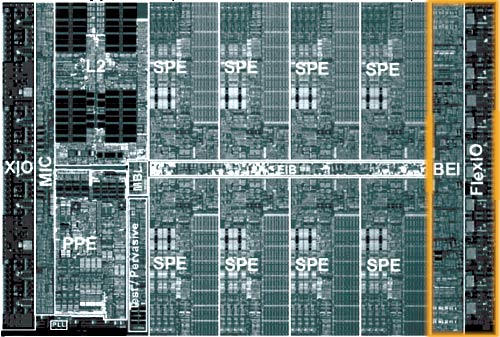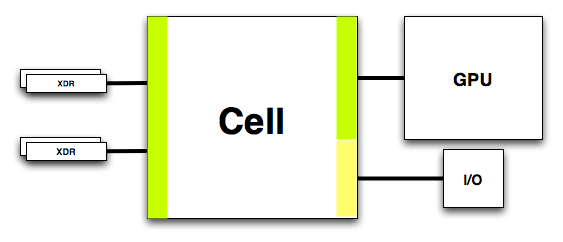Understanding the Cell Microprocessor
by Anand Lal Shimpi on March 17, 2005 12:05 AM EST- Posted in
- CPUs
Cell’s On-Die Memory Controller
For years, we’ve known that Rambus’ memory and interface technology is well ahead of the competition. The problem is that it has never been implemented well on a PC before. The Rambus brand received a fairly negative connotation during the early days of RDRAM on the PC, and things worsened even more for the company’s brand with the Rambus vs. the DDR world lawsuits.Rambus has had success in a lot of consumer electronics devices, such as HDTVs and the Playstation 2, so when Cell was announced to make heavy use of Rambus technologies, it wasn’t too surprising. As we’ve reported before, Rambus technology is used in about 90% of the signaling pins on Cell. The remaining 10% are mostly test pins, so basically, Rambus handles all data going in and out of the Cell processor. They do so in two ways:
First off, Cell includes an on-die dual channel XDR memory controller, each channel being 36-bits wide (32-bits with ECC). Cell’s XDR memory bus runs at 400MHz, but XDR memory transfers data at 8 times the memory bus clock - meaning that you get 3.2GHz data signaling rates. The end result is GPU-like memory bandwidth of 25.6GB/s. As we’ve mentioned in our coverage of this year’s Spring IDF, memory bandwidth requirements increase tremendously as you increase the number of processor cores - with 9 total in Cell, XDR is the perfect fit. Note that the GeForce 6800GT offers 32GB/s of memory bandwidth just to its GPU, so it would not be too surprising to see the Playstation 3’s GPU paired up with its own local memory as well as being able to share system memory and bandwidth.

The block labeled MIC is the XDR memory controller, and the XIO block is the physical layer - all of the input receivers and output drivers are in the XIO block. Data pipelines are also present in the XIO block.
Cell’s On-Die FlexIO Interface
The other important I/O aspect of Cell is also controlled by Rambus - the FlexIO interface. Cell features two configurable FlexIO interfaces, each being 48-bits wide with 6.4GHz data signaling rates.
The BEI block is effectively the North Bridge interface, while the FlexIO block is the physical FlexIO layer.

One potential implementation of Cell’s configurable FlexIO interface.
In Playstation 3, you can pretty much expect a good hunk of this bandwidth to be between NVIDIA’s GPU and the Cell processor, but it also can be used for some pretty heavy I/O interfaces.
One of the major requirements in any high performance game console is bandwidth, and thanks to Rambus, Cell has plenty of it.










70 Comments
View All Comments
WishIKnewComputers - Thursday, March 17, 2005 - link
Well, I dont really see the Cell 'breaking' in any way. Between being in the PS3, IBM servers/supercomputers, and Sony and Toshiba electronics, the chip will be all over the place.As for it showing up in PCs... no it wont happen anytime soon, but I really dont think it's intended to at this point. Workstation and playstations are its main concern, and smartly so. The Cell in its first generation isnt cut out for superior general tasking, obviously, but when those things start pumping out (and they will... the PS2 has sold what, 80 million units?), there will likely be different and more advanced versions. And if some of those are changed for enhanced general purposing somehow or another, then they could have shot at entering the PC world. As for taking on Intel, though... I dont think IBM is even considering that. If I had to guess, if they wanted to be in a PC, they would have OS X adapted to Cell and IBM would have these things in Apples.
But no matter which way they go, is it me or does IBM seem light-years ahead of Intel? After looking at Intel's future plans, it seems that they are trying to move towards what IBM is doing now. So is the Cell a processor just ahead of its time, or has Intel just gotten behind?
AnnihilatorX - Thursday, March 17, 2005 - link
This article is seriously a kill for a child like me. I appreciate it though. Well done Anandtechravedave - Thursday, March 17, 2005 - link
I can't wait to see what devlopers thing of the cell & the SDK's for it. I have a feeling thats what will kill the cell or make it successfull.microbrew - Thursday, March 17, 2005 - link
"System on a Chip (SoC)"What will make or break the Cell is the tools available, especially the operating system and libraries.
I would like to see what they're doing in terms of marketing the chip to consumer electronics, telecom, military and other embedded applications. I could see the Cell as a viable alternative to the usual mixures of PowerPcs, ARMs and DSPs.
I also agree with Final Words; I don't see the Cell breaking into the consumer PC market any time soon either.
Locut0s - Thursday, March 17, 2005 - link
#17 Yeah that was a bit too harsh I agree.Eug - Thursday, March 17, 2005 - link
I'm just wondering how well a dual-core PPE-based 4+ GHz chip would do in general purpose (desktop) code.And I also wonder how cool/hot such a chip would be. The Xbox 2's CPU is probably a 3-core PPE, but it runs at 3 GHz, and we don't have power specs for it anyway.
Filibuster - Thursday, March 17, 2005 - link
#11 (well, everyone should if they haven't before) read the Arstechnica article on PS2 vs PC - static applications vs dynamic media. Cell is taking it to the next level.http://arstechnica.com/articles/paedia/cpu/ps2vspc...
Very nice article Anand!
Googer - Thursday, March 17, 2005 - link
Besides a release date, is there any news or knowledge of a Linux Kit for Playstation 3 like there was for PS2? Does anyone KNOW OF Either?Illissius - Thursday, March 17, 2005 - link
Damn. Awesome article. If I hadn't known the site and author beforehand, I would've guessed Ars and Hannibal. Seems he isn't the only one with a talent for these kinds of articles ;)You should do more of them.
scrotemaninov - Thursday, March 17, 2005 - link
#22: This is just a guess so don't rely on this. The POWER5 has 2way SMT. Each cycle it fetches 8 instructions from the L1I cache. All instructions fetched per cycle are for the same thread so it alternates (round robin). It also has capabilities for setting the thread priority so that you effectively run with 1 thread and it just fetches 8 instructions per cycle for the one running thread.I would expect the PPE to be similar to this, fetching 2 instructions for the same thread each cycle. The POWER5 has load balancing stuff in there too - if one thread keeps missing in L2 then the other thread gets more instructions decoded in order to keep the CPU functional unit utilisation up. I've no idea whether this kind of stuff has made it over into the PPE, I'd be a little surprised if it has, especially seeing as this is in-order anyway so it's not like you're going to be aiming for high utilisations rates.